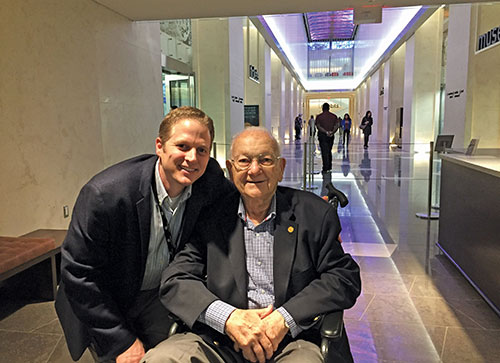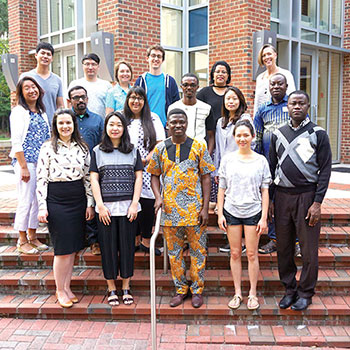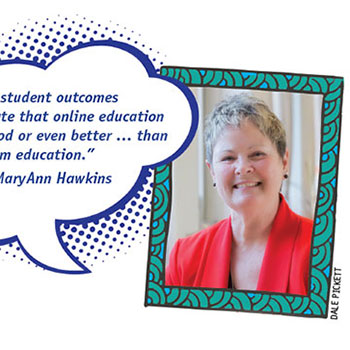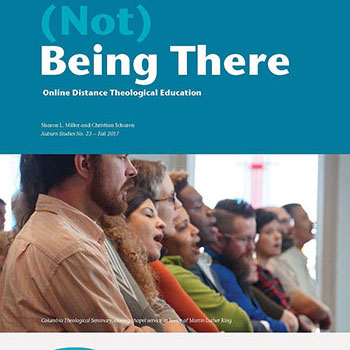
At 87, Robert E. Cooley should probably be resting on his laurels. And these days, the president emeritus of Gordon-Conwell Theological Seminary does spend a lot of time at home with Eileen, his wife of 65 years. Nevertheless, Cooley has never stopped thinking about how educators can respond to an ever-changing world.
Last fall, In Trust sat down with Cooley to ask him what seminary leaders need to be thinking about today.
An abridged and edited version of that conversation follows.
Q: In higher education, everything seems to be shifting these days. Has that always been the case, or are we living in unique times?
A: Institutions have always changed over time. But the change that we’re confronting now is a very rare form of change, a paradigm change. There have been a few of those in American history.
This country began as an agricultural society, and the first seminaries responded by educating the one intellectual in that community — the parson. Then the industrial age emerged, with its urbanization, factory work, and concerns about class stratification. Many theological schools embraced European-influenced “higher criticism” and produced ministers with stellar academic credentials. Yet at the same time, in other communities, intellectuals became suspect. In response, Bible institutes and Bible colleges were founded to keep ministerial preparation closer to the people in the pews and to uphold the importance of the English-language text of the Scriptures.
But in the late 20th century, society was changing again, from an industrial to an information society. And the internet sped up that change.
Q: Why is this a challenge for seminaries today?
A: A board of a theological school today has to spend a great deal of time in understanding the new rules and the new practices of the information age. Theological education is built on tradition, and it’s very difficult for theologians and faculty members — who have been trained in a discipline all of their lives — to make a paradigm shift.
It’s hard for me, trained in teaching the Bible via lecture, to realize that the nature of teaching and learning is so completely different now. How do I take the best of the lecture pedagogy and practice it in an information age? Can I transform it into a story of no more than 900 characters? Now, for me, that’s hard work.
Furthermore, today the lecturer is no longer the fount of ever-flowing information. If a student wants to know something, the student picks up a laptop or pulls out a smart phone. We have a generation that expects immediate information, and they’re good at finding it.
Just as there’s no one right way to teach any more, there’s also no one right way to operate an educational institution. As educators we tend to think, “There’s a right theory that grows into a right practice — there’s a right way to do it.”
But today, while there are wise practices, there’s no prescription that we can give to our schools or our boards that says, “If you take these steps, you will thrive.” Each school is unique. Each has its own heritage, its own accumulated values. Once you get beyond the marketing-speak — the refectory, the exercise track — and get down into an institution’s history, its founding, and the values that were built into it over the years, you can see its uniqueness. And it’s those dynamics that control the future of that school and have to be taken into account as we respond to paradigm change.
Some pretty good schools with world-class faculties have gone out of business because they ignored the uniqueness that was deep within the lifeblood of the institution.
Q: Institutional transformation is a hard task for a president and a board to undertake, given that so many are focused on day-to-day survival. The only places that real transformation seems to be taking place are in schools that are so near to closing that the board has empowered their leaders to think about the future in different ways.
A: A committed board is willing to discern the reality of an institution, and of the macro-environment, and to provide for change. Board members who are passionate for the institution bring in the wisdom of the marketplace, of the church, of the congregation. And they see big-picture issues not so much through the eyes of tradition but through the eyes of reality.

A: First, globalization. Ministerial training has shifted its focus. If theological education started by serving the needs of the farming village, and then expanded its horizons to the town and the city, today theological schools are open to the world. You see this in theological school enrollment statistics. There are about 72,000 students enrolled in accredited theological schools in the United States and Canada, and of these, about 40 percent are either students of color or international students.
When I arrived as president of Gordon-Conwell Theological Seminary in 1981, the two changes that we had to accommodate were second-career students with families, and the arrival of women pursuing ordination. But the traditional structures and assumptions of higher education, derived from England and Germany, mostly continued.
Today it’s different. You take a concept like family. If you have 40 percent Latinos, Koreans, and Africans in your class, they’re going to view notions of the family differently than your average student from 1981. I’m not sure our faculties are really prepared to deal with these differences.
Secondly, there is a huge issue of how we manage new knowledge. You and I are living on a transformational threshold. We still have one foot in the industrial age, and we’re trying to plant another in the information age. But it takes a generation to cross that threshold. Our knowledge is being expanded at a rate that we’re not able to handle.
For example: How can theologians help our students prepare for a ministry that will have to address questions of artificial intelligence? We have taught for a long, long time that the basis for morality is willful determination. Can I now allow a robot to determine my moral will?
We need our biblical scholars and theologians to provide ways to think about this, because our graduates are going out into ministry settings where they will confront these issues in a congregation or a parish.
Third is the need for collaboration. No school can exist in isolation today. The question is: who are they in collaboration with? Some have done a good job in connecting with community organizations and have built networks. Others have built good networks in collaboration with congregations and church structures. Now, what are ways that theological schools can collaborate with other theological schools?
In an ancient Greek city, the agora was a place for the interaction of ideas. The Roman forum added a market dimension to the agora and turned it into an economic center. The cathedral square grew out of that. In England and New England, the village green was the next iteration of the cathedral square. All village events took place in the village green. It was a place for the exchange of ideas.
In the 1950s and ’60s, when the shopping mall came along, it absorbed that function and became the center of the exchange of ideas. But now malls are dead. What has replaced them? The online public square. Cyberspace is where ideas are exchanged, and ideas are always the instigators of change.
Fourth, the nature of authority is changing. During the industrial age, authority was defined as a bureaucratic function. If you look at organizational charts from the industrial period, they’re always built on a vertical axis. Information was stratified.
Likewise, the traditional theological school is a product of denominations. Denominations were formed in America under bureaucratic authority, with power flowing from the top down. If you need more information in a denominational structure, or more authority to act, you climb the bureaucratic ladder to get the information or obtain the authority. The assumption is that when you arrive at the office of the General Superintendent (or the Presiding Bishop or the Moderator of the General Assembly), you are at the source of all information, and that person has the plenary authority to act.
But hierarchies have broken down, and now authority is more horizontal. Unusually, higher education has been ahead of that curve. When you stop to think about it, “shared governance” is horizontal empowerment. If it’s truly carried out in the right way, it’s authority that is shared between the board, the administration, and the faculty.
The industrial age worked with structural functionalism, so we built silos. Now, as we live into a paradigm with flatter power structures, how do we build team systems within the life of our theological schools?
Finally, there’s the changing nature of young people’s worldview. When I look at the statistics published by the Pew Research Center, I see that the religiously unaffiliated, the “nones,” now make up almost a quarter of the U.S. population. And when I start to delve into the reasons, I find a new worldview — one that the church isn’t addressing. For example, my own grandkids are fed up with religion, but they’re very excited about spirituality. To me, this is a worldview question.
I think that these five dominant forces are driving a paradigm shift. My question is: how do a board and president respond to these changes? How do we form ministers in a time such as this? The same way we’ve always done?
This interview was edited by Jennifer L. Woodruff Tait.
Always digging deeper
Born in 1930, Robert E. Cooley has been observing higher education since he first stepped onto the Central Bible College campus at age 18. He taught at Wheaton College and at Evangel College before being named professor of anthropology and religious studies at Southwest Missouri State University. An archaeologist, Cooley has directed numerous excavations in the Middle East and North America.
In 1981, Cooley was appointed the second president of Gordon-Conwell Theological Seminary, which he led for 16 years before being named chancellor, and then president emeritus. He served as the In Trust Center’s second board chair from 1999 to 2005.

Here he is pictured with Seth Pollinger, director of content at the new Museum of the Bible in Washington, D.C., where Cooley was formerly vice chair of the board.




























